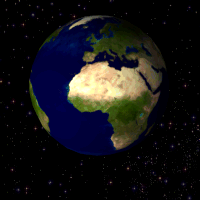 An animated GIF of a rotating globe | |
| Filename extension | .gif |
|---|---|
| Internet media type | image/gif |
| Type code | GIFf |
| Uniform Type Identifier (UTI) | com.compuserve.gif |
| Magic number | GIF87a/GIF89a |
| Developed by | CompuServe |
| Initial release | 15 June 1987[1] |
| Latest release | 89a 1989[2] |
| Type of format | lossless bitmap image format |
| Website | www |
The Graphics Interchange Format (GIF; /ɡɪf/ GHIF or /dʒɪf/ JIF, ) is a bitmap image format that was developed by a team at the online services provider CompuServe led by American computer scientist Steve Wilhite and released on June 15, 1987.[1]
The format can contain up to 8 bits per pixel, allowing a single image to reference its own palette of up to 256 different colors chosen from the 24-bit RGB color space. It can also represent multiple images in a file, which can be used for animations, and allows a separate palette of up to 256 colors for each frame. These palette limitations make GIF less suitable for reproducing color photographs and other images with color gradients but well-suited for simpler images such as graphics or logos with solid areas of color.
GIF images are compressed using the Lempel–Ziv–Welch (LZW) lossless data compression technique to reduce the file size without degrading the visual quality.
While once in widespread usage on the World Wide Web because of its wide implementation and portability between applications and operating systems, usage of the format has declined for space and quality reasons, often being replaced with video formats such as the MP4 file format. These replacements, in turn, are sometimes termed "GIFs" despite having no relation to the original file format.[3]
- ^ a b "Graphics Interchange Format, Version 87a". W3C. 15 June 1987. Archived from the original on 22 December 2018. Retrieved 13 October 2012.
- ^ "Graphics Interchange Format, Version 89a". W3C. 31 July 1990. Archived from the original on 22 December 2018. Retrieved 6 March 2009.
- ^ Tiffany, Kaitlyn (7 October 2022). "The GIF Is on Its Deathbed". The Atlantic. Retrieved 21 October 2023.